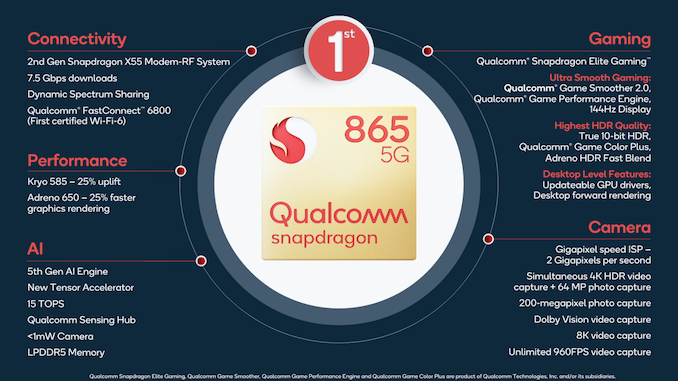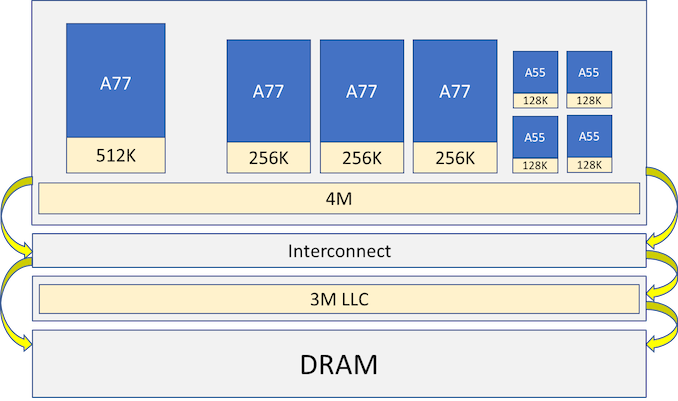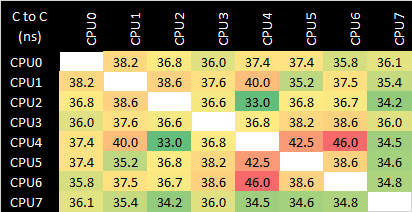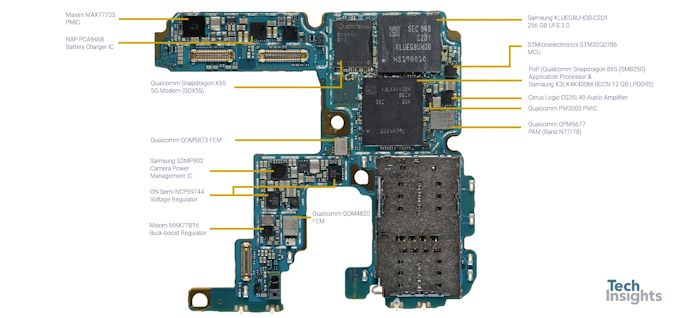The Samsung Galaxy S20+, S20 Ultra Exynos & Snapdragon Review: Megalomania Devices
by Andrei Frumusanu on April 3, 2020 9:30 AM ESTThe Snapdragon 865 SoC: Beating Expectations
We’ve covered the Snapdragon 865 extensively over the last few months, and more recently did a performance preview of the chip on the Galaxy S20 Ultra:
-
Qualcomm Announces Snapdragon 865 and 765(G): 5G For All in 2020, All The Details
-
The Snapdragon 865 Performance Preview: Setting the Stage for Flagship Android 2020
-
Samsung Galaxy S20 Ultra (Snapdragon 865) Quick Performance Preview: Impressive
It’s safe to say that Qualcomm managed to beat our expectations in terms of power efficiency improvements. Which is something we’ll go over in more detail in this piece as well.
At the heart of the Snapdragon 865 we find Arm’s newest Cortex-A77 CPU cores. The new microarchitecture is said to bring a 20-25% IPC improvement over its predecessors, and that’s where the new SoC derives most of its performance improvements from, as the clock frequencies of the cores are identical to that of last year’s Snapdragon 855.
One aspect where Qualcomm did improve the design is in doubling the shared L3 cache of the CPU cluster, going from 2MB to 4MB. Not only does this further improve the performance of the CPUs by allowing for more data to be cached on-chip, but Qualcomm has explained that one of the primary reasons for this was to also improve power efficiency of the SoC by reducing how often the SoC has to access the DRAM, which is a relatively power-expensive operation.
The chip still has a 3MB system level cache that serves the various IP blocks on the SoC – it’s again meant to not only improve performance but also improve power efficiency as it avoids external memory accesses. The memory subsystem here is smart and detects when to bypass this cache when there’s latency-sensitive workloads, and in general we’ll see some massive memory subsystem improvements on the part of the Snapdragon 865 in a later dedicated section.
All the CPUs being in the same cluster and cache hierarchy means that the core-to-core latencies are relatively uniform, only differing based on their frequencies and lower level cache access latencies. It’s not too much of an exciting metric here, but it’s important context to have as we’ll consider the Exynos 990’s CPU topology in just a bit.
Again, we’ve covered the Snapdragon 865 quite extensively in the above linked articles so I recommend reading them again for other details on other parts of the new chip, such as the new ISP, DSP, and GPU details. However, one aspect that’s very defining for the flagship Qualcomm chipset this year is that the company is separating the modem from the SoC – essentially making the SoC just an application processor for this generation.
The external nature of the X55 modem has a few implications: first of all, there’s an additional component on the motherboard which vendors will have to make space for, which means additional cost. Secondly, there’s the big question of how power efficiency will be affected by the external modem. We’ve seen Apple devices perform excellently over the years while never having an integrated modem, and I feel like the Snapdragon 865 and X55 also fall into this classification, as I haven’t seen any major differences in efficiency due to the external nature of the modem.














137 Comments
View All Comments
Danish_92 - Tuesday, April 7, 2020 - link
why are these big brands suddenly focusing on big cameras?surt - Tuesday, April 7, 2020 - link
I'd say they're focusing on camera GPU performance, which are the two areas of the phone where performance is not yet 'good enough'. Everything else just ... works.s.yu - Tuesday, April 7, 2020 - link
They're focusing on anything that makes a selling point that people could care about. They also focused on the haptic motors and most mid-high tier phones should vibrate better than those 3-4 years ago.watzupken - Wednesday, April 8, 2020 - link
Big brands are focusing on big cameras because they see Chinese phones, in particular Huawei, making a lot of waves in this area. Since it is very difficult to differentiate their products especially for Android phones, thus, whatever seems to rock with the consumer, every manufacturer will double down on the same features. First it was SOC, then they start spamming ram, follow by cameras, higher screen to body ratio, and now high refresh rate screen. You can tell Samsung is purely focusing on these areas I have mentioned as well.colonelclaw - Tuesday, April 7, 2020 - link
A slightly unfortunate time to launch such an expensive product. I don't know about you all, but right now I'm saving every penny I can.peevee - Wednesday, April 8, 2020 - link
"Why Samsung is able to call this a 3x telephoto module is that when cropping a 1:1 12MP picture out of it, it does end up at a 3x magnification in relation to the main camera sensor."3x magnification by the sensor would crop 8 out of 9 pixels. For 64MP original, it would be 7.1MP, not 12.
flyingpants265 - Thursday, April 9, 2020 - link
No front speakers = no buy.Crappy smartphone OS with no proper multitasking, on a phone with 16 gigs of RAM = no buy.
Can't turn off Google phoning home in software = no buy.
$999 = DEFINITELY no buy. Pay about $300 for a used S10. Don't be a sucker.
StrangerGuy - Thursday, April 9, 2020 - link
I just ordered a brand new SD845 Note 9 for $350 to replace my current Exynos Note 9 with OLED black banding issues out-of-warranty. Replacing the screen aftermarket would cost $250 alone.Anyway, I have no idea why anybody would want to pay $1000+ of IQ deficiency taxes for the current breed of half-baked Samsung phones. Even their home appliances and TVs are also rubbish in terms of value per dollar.
helloworld_chip - Sunday, April 12, 2020 - link
Do we have 990 kirin 5G GPU efficiency data for comparison? Would be glad to see if it also shows big efficiency improvements over the 4G version.snarfbot - Sunday, April 12, 2020 - link
How does the 855+ stack up